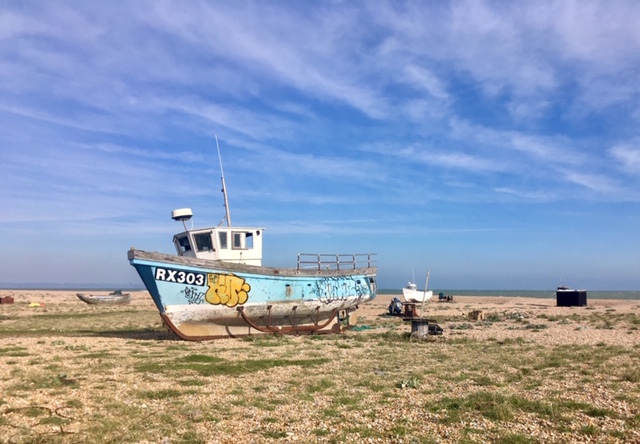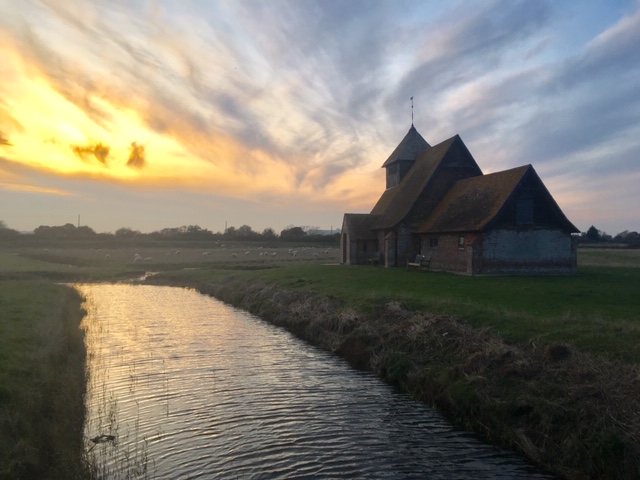Dungeness, in late autumn, was everything I expected it to be. A windswept and seemingly barren landscape, punctuated by power lines and quirky houses, with a nuclear power station backdrop. I loved it.

Some readers may be familiar with the status of Dungeness as the only desert in the UK. It was one of the facts I thought I knew about the area but the Met Office refuted it a few years ago. Evidently it gets too much rain! However Wikipedia provides plenty of alternatives for fact lovers. Did you know Dungeness comprises one of the largest shingle areas in Europe, has over 600 different types of plant or was the location for a Soup Dragons video in 1990?

Dungeness beach
Armed with the aforementioned knowledge we explored Dungeness via a Discovering Britain walk. The 3 mile route starts from the car park by one of the lighthouses. If you visit at the right time of year (generally summer and school holidays) you can climb the tower. We were out of luck so contented ourselves with a view from the bottom.

With our backs to the nuclear power station we followed a boardwalk across the shingle towards the sea. Down on the waterfront waves crashed against the stones. It’s not a beach you’d head to for a bucket and spade holiday but there were plenty of people fishing by the shoreline. Warm water pumped from the power station evidently attracts small creatures, acting as bait for fish. I wonder if they glow in the dark too?

We backtracked along the boardwalk, walked along the road for a bit and then headed off towards the beach again. Although it is rather hard to distinguish exactly where the beach starts and ends as the whole headland is covered in shingle. The shingle is home to a mix of shipping containers, rusty machinery and abandoned fishing nets and boats, some seaworthy, some not. It’s a Mad Max kind of place.

We stopped for the obligatory photo at Derek Jarman’s house, Prospect Cottage. Although the film director died in 1994 his famous shingle garden continues to be maintained and is still one of the major draws at Dungeness.
Despite the shack like appearance of some of the houses others look like they’re straight out of Grand Designs, with price tags to match. We saw one in a local estate agents for just under a million pounds. These designer boxes mingle with converted railway carriages and coastguard cottages although I do wonder how many are residential properties compared to holiday rentals.

After lunch at The Pilot Inn we looped back towards the car park, across yet more shingle. Our route followed a long line of wooden posts, a delineation between the nuclear power station and the railway track which brings day trippers from Hythe. With such a close up view of the nuclear power station it was hard not to think of our recent TV viewing, Chernobyl. Fortunately our return to the car park passed without incident!
RSPB Dungeness
Our next stop was RSPB Dungeness reserve, a couple of miles away. Here we found flooded gravel pits and er, more shingle. At the visitor centre you can use the pre-erected telescopes to spot wildfowl on the water; alternatively pick up a map and head out to one of the hides dotted around the reserve.

The teens, avid wildlife watchers that they are, decided to stay in the car whilst we walked round. Two of the species I hoped to spot were the, admittedly elusive, bittern and bearded tits. I didn’t really hold out much hope for the bittern but the bearded tits were a different matter. Despite hanging around their special feeding posts our luck was out on both counts. Next time!
Denge sound mirrors
After leaving the reserve we drove to Lade Pits, another RSPB site. Aside from birds most visitors come to see the sound mirrors, huge concrete structures built between 1928 and 1935. These were constructed to pick up sounds from enemy aircraft approaching over the English Channel. However the introduction of radar technology meant they quickly became obsolete.
The sound mirrors are on a small island, accessed via a swing bridge on special opening days only although you can get close enough to see them without crossing to the island. Don’t make the same mistake as us; the late afternoon sun makes it impossible to take good photographs so visit earlier in the day.
Romney Marsh Church
Our final stop of the day was a race against the setting sun. Low lying Romney Marsh is famous for its churches. I’d seen a photograph of St Thomas à Becket church in the ‘lost village’ of Fairfield on the front of our OS map and was determined to visit.

After parking in a small lay-by we crossed a small field full of sheep, and copious amounts of sheep poo, to reach the church. The church sits on a small grassy island, surrounded by ditches and a stream. If we’d have been earlier, and more organised, we could have picked up the key to unlock the church from a nearby farm.
Instead we contented ourselves with a sunset view and then picked our way back across the poo covered field.
Dungeness was a worthy entry on my UK bucket list. I’m happy that I finally managed to visit, although I am also glad that we decided to stay in nearby Rye rather then Dungeness itself!
